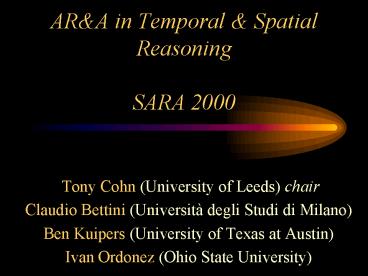AR - PowerPoint PPT Presentation
Title:
AR
Description:
qualitative relations. relevant abstractions. Qualitative Spatial Representations ... Qualitative relations (eg sector orientations) ... – PowerPoint PPT presentation
Number of Views:23
Avg rating:3.0/5.0
Title: AR
1
ARA in Temporal Spatial ReasoningSARA 2000
- Tony Cohn (University of Leeds) chair
- Claudio Bettini (Università degli Studi di
Milano) - Ben Kuipers (University of Texas at Austin)
- Ivan Ordonez (Ohio State University)
2
ARA in Temporal and Spatial Reasoning.
- the role of ARA in ST reasoning
- the types of abstraction and approximations that
are useful for ST reasoning - the differences in the use of abstraction and
approximation in ST reasoning - wish list for work on ARA in ST
- ...
3
(No Transcript)
4
Abstraction in Spatial ReasoningWhy?
- Efficiency
- eg quad trees for very large spatial DBs
- Data integration
- DBs may contain data at different scales
- HCI
- eg Cartographic generalisation
- eg high level queries (incl. NL)
- Spatial planning (eg navigation)
- High level vision
- ...
5
Kinds of spatial abstraction
- Regions rather than points (aggregation)
- granularity shifts (eg pixel size)
- dimension changing
- qualitative relations
- relevant abstractions
- ...
6
Qualitative Spatial Representations
7
Changing scale Baarle-Nassau/ Baarle-Hertog (tha
nks to Barry Smith for the example)
8
Approximation
- Qualitative relations
- (eg sector orientations)
- Regions, and regions with indeterminate
boundaries - the egg/yolk calculus
- X is crisper than Y
...
9
(No Transcript)
10
Conceptal neighbourhoods approximation
- Conceptual neighbourhoods give next relation
- Uncertainty of relation gives connected sub-graph
- e.g. composition table entries
11
(No Transcript)
12
Finer grained representations can be more
efficient
- Constraint satisfaction in CYCORD is NP complete
- 24 relation calculus is polynomial on base
relations - Similarly tractable subsets of RCC8, RCC5,..
- Cf Buerkert Nebels analysis of Allen
13
Reformulation
- RCC 1st order theory ? Zero order formulation
- 9-intersectionDEM (81 relations) ? CMB (5
polymorphic relations) - spatial analogies reformulating other domains as
a spatial problem - eg view database class integration as a spatial
problem using egg/yolk theory - global orientation ? local orientation
- Vector ? raster
14
Intuitionistic Encoding of RCC8 (Bennett 94)
- Motivated by problem of generating composition
tables - Zero order logic
- Propositional letters denote (open) regions
- logical connectives denote spatial operations
- e.g. Ú is sum
- e.g. Þ is P
- Spatial logic rather than logical theory of space
15
Decidable, tractable representation
- Represent RCC relation by two sets of
constraints - model constraints entailment
constraints - DC(x,y) xÚy x, y
- EC(x,y) (xÙy) x, y, xÚy
- PO(x,y) --- x, y, xÚy, yÞx, xÚy
- TPP(x,y) xÞy x, y, xÚy, yÞx
- NTPP(x,y) xÚy x, y , yÞx
- EQ(x,y) xÛy x, y
16
9-intersectionDEM
- DEM when entry is , replace with dimension
of intersection 0,1,2 - 81 region-region relations
17
? CMB (5 polymorphic relations)
- disjoint x Ç y Æ
- touch (a/a, l/l, l/a, p/a, p/l) x Ç y Í b(x) È
b(y) - in x Ç y Í y
- overlap (a/a, l/l) dim(x)dim(y)dim(x Ç y) Ù
x Ç y ¹ Æ Ù y ¹ x Ç y ¹ x - cross (l/l, l/a) dim(int(x))Çint(y))max(int(x)),
int(y)) Ù x Ç y ¹ Æ Ù y ¹ x Ç y ¹ x - EG touch(L,A) Ù cross(L,b(A)) Ù
- disjoint(f(L),A) Ù
disjoint(t(L),A)
18
Research issues
- Moving between abstraction levels
- Qualitative/quantitative integration
- Choosing abstraction level
- Expressiveness/efficiency tradeoff
- Cognitive Evaluation
- Ambiguity
- ...































